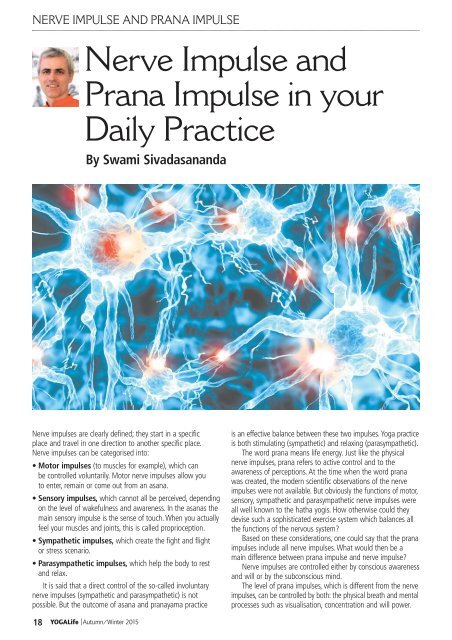Celebrating The First International Day of Yoga
Yoga_Life_Winter_2015_WEB
Yoga_Life_Winter_2015_WEB
Create successful ePaper yourself
Turn your PDF publications into a flip-book with our unique Google optimized e-Paper software.
NERVE IMPULSE AND PRANA IMPULSE<br />
Nerve Impulse and<br />
Prana Impulse in your<br />
Daily Practice<br />
By Swami Sivadasananda<br />
Nerve impulses are clearly defined; they start in a specific<br />
place and travel in one direction to another specific place.<br />
Nerve impulses can be categorised into:<br />
• Motor impulses (to muscles for example), which can<br />
be controlled voluntarily. Motor nerve impulses allow you<br />
to enter, remain or come out from an asana.<br />
• Sensory impulses, which cannot all be perceived, depending<br />
on the level <strong>of</strong> wakefulness and awareness. In the asanas the<br />
main sensory impulse is the sense <strong>of</strong> touch. When you actually<br />
feel your muscles and joints, this is called proprioception.<br />
• Sympathetic impulses, which create the fight and flight<br />
or stress scenario.<br />
• Parasympathetic impulses, which help the body to rest<br />
and relax.<br />
It is said that a direct control <strong>of</strong> the so-called involuntary<br />
nerve impulses (sympathetic and parasympathetic) is not<br />
possible. But the outcome <strong>of</strong> asana and pranayama practice<br />
is an effective balance between these two impulses. <strong>Yoga</strong> practice<br />
is both stimulating (sympathetic) and relaxing (parasympathetic).<br />
<strong>The</strong> word prana means life energy. Just like the physical<br />
nerve impulses, prana refers to active control and to the<br />
awareness <strong>of</strong> perceptions. At the time when the word prana<br />
was created, the modern scientific observations <strong>of</strong> the nerve<br />
impulses were not available. But obviously the functions <strong>of</strong> motor,<br />
sensory, sympathetic and parasympathetic nerve impulses were<br />
all well known to the hatha yogis. How otherwise could they<br />
devise such a sophisticated exercise system which balances all<br />
the functions <strong>of</strong> the nervous system?<br />
Based on these considerations, one could say that the prana<br />
impulses include all nerve impulses. What would then be a<br />
main difference between prana impulse and nerve impulse?<br />
Nerve impulses are controlled either by conscious awareness<br />
and will or by the subconscious mind.<br />
<strong>The</strong> level <strong>of</strong> prana impulses, which is different from the nerve<br />
impulses, can be controlled by both: the physical breath and mental<br />
processes such as visualisation, concentration and will power.<br />
18 YOGALife |Autumn/Winter 2015



